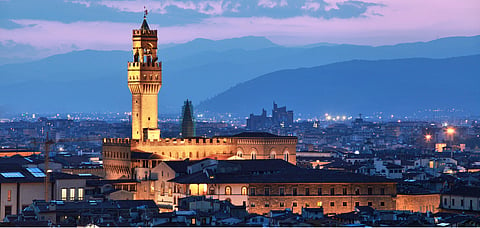
- Destinations
- Experiences
- Stay
- What's new
- Celebrating People
- Responsible Tourism
- CampaignsCampaigns
- SubscribeSubscribe
- Buy Now

He has full lips, a prominent Adam&rsquos apple and a profile that&rsquos right out of 15th century Florence. He has his eyes gouged out, ominously corroborating tour guides&rsquo claim that it&rsquos the image of either a heckler or a man headed for execution. He also has a curly mop, possibly of a less fortunate pedigree than that of his neighbour David, but enough to suggest that this man, who has been addressed by Florentines as L&rsquoImportuno di Michelangelo (literally, 'Nuisance') for ages, is the covert job of Renaissance great Michelangelo himself.
Art historian Adriano Marinazzo has established a fresh connection between an ignored work from the Renaissance master&rsquos Louvre archive, believed to be created when he was 13 years old, and the stray point of interest carved on the historic town hall building, providing fresh fire to the contention that it was indeed made by Michelangelo. The development has rekindled the perennial excitement surrounding the work in the art world, and sent residents and travellers alike in a tizzy.
A whole body of folklore goes around the historical city concerning the origin of the piece of art&mdashsome contend that Michelangelo did as part of a challenge where he was supposed to draw with his back to the wall, while others hold that it was a pilloried public offender that he etched here.
If Marinazzo is right, Michelangelo carved the face in the wall of Palazzo Vecchio when he came visiting for the installation of David, his iconic 17-foot marble sculpture, in the year 1504. One is bound to have real fun imagining a twenty-something Michelangelo surreptitiously carving the profile in the wall in the wee hours of the morning metres away from where the massive sculpture would be placed half a day hence, just like in an Umberto Eco book
On a serious note, it was impossible to make short work of the wall thus, which is why believers haven&rsquot quit calling the work Michelangelo&rsquos&mdashsince apparently only he could have the finesse and skill for the job. Moreover, the site is one that has always been under close watch of the security and thus couldn&rsquot have been made by vandals.
Those who don&rsquot believe it to follow Michelangelo&rsquos style probably forget what the sculptor wrote in his short note accompanying the original work that has become the point of reference. Preempting future doubt as regards the style of the work, he states, &ldquoWho would ever say it was [by] my hand&rdquo
Read When in Rome, Walk
As we mentioned earlier, all sort of lore has gone around in the city about it being the profile of a man who was being taken for execution, but Marinazzo doesn&rsquot discount the possibility of it having been a portrait of Francesco Granacci&mdasha friend of Michelangelo&rsquos&mdashand not exactly the man that the latter had sketched in his teenage. Granacci was also on the committee set up to see through the approval of David&rsquos installation, along with Sandro Botticelli and Leonardo da Vinci.
